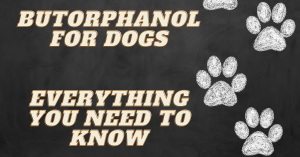





Butorphanol for dogs is a therapeutic drug that many vets prescribe to relieve cough. Sometimes, this medication is also used for anti-congestion, and is effective in relieving pain in animals, including canines and horses.
Many pet owners are opting to medicate with butorphanol. For dogs, this typically isn’t an issue. However, there are some things you should take into consideration before giving your furry friend any medication.
As a veterinarian, I always recommend checking in with your pet’s doctor prior to administering any medication. This article is a good place to start before discussing potential treatment with your vet.
If you’d rather listen to this blog, just click play on the SoundCloud audio below:
Butorphanol for Dogs at a Glance – Top 13 FAQ



Today we’ll take a look at the top 13 questions about butorphanol for dogs that I regularly get asked by dog owners. Later in the article, we’ll take a more in-depth dive to help you decide if the drug is right for you and your pet.
If you’d like to know more about home medications that can help your pet, check out our vet-approved list below.
| Dyne for Dogs: For Energy & Weight Gain | Omeprazole for Dogs: For Ulcers & Inflammation | Enrofloxacin for Dogs: For Bacterial Infections |
Cefpodoxime for Dogs: For Bacterial Infections | Sucralfate for Dogs: Chronic Upset Stomach | Cosequin for Dogs: For Joint Health |
| Ursodiol for Dogs: For Liver & Gallbladder | Trazodone for Dogs: For Anxiety & Aggression | Mometamax for Dogs: For Ear Infections |
| Credelio for Dogs: For Ticks & Fleas | Chlorpheniramine for Dogs: For Allergy-Related Conditions | Butorphanol for Dogs: For Painful Coughs |
| Dinovite for Dogs: For Irritating, Itchy Coat | Dasuquin for Dogs: For Joint Health | Meloxidyl for Dogs: For Pain & Inflammation |
| Glandex for Dogs: For Digestive Support | Rilexine for Dogs: For Bacterial Infections | Enalapril for Dogs: For Cardiac Conditions |
| Quercetin for Dogs: For Allergy & Inflammation | Carprovet for Dogs: For Pain & Inflammation | Pimobendan for Dogs: For Congestive Heart Failure |
| Simplicef for Dogs: For Bacterial Infections | Clindamycin for Dogs: For Bacterial Infections |
Until then, check out our vet’s info on butorphanol for dogs.
So, what are we waiting for? Let’s get started!
Q: What is butorphanol for dogs?
A: Butorphanol is a prescription medication that is commonly used in dogs as a pain reliever and cough suppressant. It belongs to the class of drugs known as opioids.
Q: What types of pain can butorphanol be used for in dogs?
A: Butorphanol can be used to manage mild to moderate pain in dogs, such as pain from surgery, dental procedures, or injuries.
Q: What are the possible side effects of butorphanol in dogs?
A: Common side effects of butorphanol in dogs may include sedation, nausea, vomiting, constipation, and decreased respiratory rate. In rare cases, it may cause more severe side effects such as respiratory depression, seizures, or an allergic reaction.
If you suspect your dog is having any adverse reactions to medication, stop use immediately and contact you vet.
Q: Can butorphanol be given to pregnant or nursing dogs?
A: Butorphanol should be used with caution in pregnant or nursing dogs, as it may pass through the placenta or milk and affect the developing fetus or puppies. It is important to consult with a veterinarian before using butorphanol for dogs in these cases.
Q: Is butorphanol safe for all dogs?
A: Butorphanol is generally safe for most dogs when used as directed by a veterinarian. However, it should not be used in dogs with a known hypersensitivity to opioids or other respiratory depressants.
Q: Can butorphanol be given with other medications?
A: Butorphanol may interact with other medications, such as sedatives or tranquilizers, which may increase its sedative effects. It is important to inform the veterinarian of any other medications the dog is taking before starting butorphanol treatment.
Q: How long does it take for butorphanol to start working in dogs?
A: The onset of butorphanol for dogs can vary depending on the method of administration and the dog’s individual response to the medication. In general, it may take a few minutes to see improvement in the dog’s symptoms.
Q: Can butorphanol be used long-term in dogs?
A: Butorphanol is not recommended for long-term use in dogs due to the risk of developing tolerance or dependence on the medication. It should only be used as directed by a veterinarian and for the prescribed duration of treatment.
Q: How should butorphanol be stored?
A: Butorphanol should be stored at room temperature and kept out of reach of children and pets. The medication should be kept in its original container and away from moisture and light. It is important to dispose of any unused medication properly.
Q: Is Butorphanol a sedative for dogs?
A: Butorphanol is a suitable medication for reducing cough when given to canines. In addition, it is sometimes used in higher doses as a sedative for canines and horses with a vet’s monitoring.
Q: How often can I give my pet butorphanol?
A: The dose of this medication is 0.05 to 0.4 mg per pound. Butorphanol is given two to six times per day to dogs. The dose varies depending on the administration route and to the animals it is given. Therefore, this drug should only be administered by asking your vet.
Q: How is butorphanol supplied?
A: Butorphanol is available in tiny compressed oral tablets and different concentrations, including 1 mg, 5 mg, and 10 mg. Capsules are also available in gelatin or veggie form and are taken orally.
Moreover, this medication is also available in injection forms having a concentration of 0.5mg/ml, 1mg/ml, 2mg/ml, and 10mg/ml. These suspensions are water-based and are present in a wide range of flavors. Not only that, but a 10mg/ml nasal spray is also available in the market.
Q: Can handling this medication be harmful to my family or me?
A: Generally, no specific precautions are needed while handling this drug. But if you or your family member is allergic to this medication, a problem might occur. However, wash your hands properly after dealing with this drug.



Let’s take a bit of a closer look and answer some of the above questions in more detail.
What Is Butorphanol for Dogs?
Butorphanol for dogs is an inexpensive route to take for treating certain conditions your pet might be facing. It’s sold under several brand names (Stadol®, Torbutrol®, Torbugesic®, Dolorex®) and is considered a level IV-controlled substance which in most cases, must be prescribed by a vet.
A vet may suggest Butorphanol for dogs for various purposes, such as:
- Pre-anesthetic
- Antitussive (Cough suppressant)
- Analgesic (Pain relieving medication)
- Antiemetic (Prevents vomiting)
Butorphanol is used in cats and canines for different conditions and is an IV-controlled substance. It is an “off-label” or “extra-label” medication, but you must follow your vet’s guidance. That’s because his directions might differ from those mentioned on the label.
How Does Butorphanol for Dogs Work?
Butorphanol is a short-term medication and is effective for mild to moderate pain. It also works as an antagonist to morphine.
In addition, Butorphanol reverses the effects of opioids acting as pain control. After getting one or two doses, you will notice positive results in your pet.
How Is Butorphanol for Dogs Given?
Butorphanol for dogs is usually given orally in the form of a tablet. Additionally, it can be given intravenously, intramuscularly, and subcutaneously in an injectable solution.



You can generally self-administer oral medication with or without food. However, getting your vet’s help when administering the injectable solution is better.
What is Butorphanol for Dogs Used For?
Butorphanol is an FDA-approved drug, cough suppressant, and canine pain reliever. In addition, it can be used as a restraining agent and sedative when combined with other drugs. Your vet will understand better why this medication is suitable for your pet in certain conditions.
Butorphanol for Dogs Side Effects
Generally, this medication is short-acting and works within 24 hours of administration in your pet’s body. However, if your dog has reduced kidney or liver function, the effect of this drug will usually last longer. Therefore, side effects can occur, such as:
Sometimes, the high doses can affect the central nervous system badly, resulting in:
- Cardiovascular changes
- Seizures
- Respiratory depression
If you suspect your pet has had an adverse reaction to this or any other drug, stop use and contact your vet right away.
Are There Any Risk Factors for Butorphanol?
This medication is not recommended for pets that are hypersensitive to it. Symptoms like skin rash, hives, swelling of the face, vomiting, or trouble breathing show that your pet is allergic to the drug. Contact your vet immediately in such a situation.
Also, if your pet already has liver disease, severe kidney impairment, and lower respiratory tract disease, tell your vet before starting the treatment.
This drug should be handled carefully in canines having MDR1 mutations. This mutation is common in Collies, Silken Windhounds, Australian Shepherds, and Shetland Sheepdogs. In such breeds, your vet will reduce the dose of this medication by 25-50%.



Remember this medication is not recommended for pregnant or breeding canines and other animals. In the case of lactating dogs, Butorphanol should be used carefully.
Are There Any Drug Interactions with Butorphanol for Dogs?
Following are the drugs that you should use carefully with Butorphanol:
- Desmopressin
- Erythromycin
- Diuretics
- Cimetidine
- Bromocriptine
- Apomorphine
- Tramadol
- Vasodilators
Also, inform your vet about the vitamins, supplements, or herbal therapies your pet is already using.
Does Butorphanol Administration Need Any Monitoring?
In the case of high doses, you should monitor your pet’s respiratory rate carefully. In addition, bowel function, urinary function, appetite, and central nervous system effects should also be monitored.



You should report any changes in these effects to a vet immediately. Besides, pet monitoring by a vet is also essential to ensure the drug works.
Things to Do If You Miss Giving a Dose of Butorphanol to My Pet
In the case of a missing dose, please give it to your pet when you remember. After that, wait for some time between doses recommended by your vet before giving another one. However, avoid giving double or extra doses as they are not safe.
Storage of Butorphanol for Dogs
You should keep Butorphanol tablets away from bright light. The room temperature recommended for the storage is 20℃ to 25 ℃ (68°F to 77°F). Avoid letting this injection liquid freeze.
Ensure to keep this medication out of children’s reach or from other animals for which it is not recommended. Ask your pharmacist or read the details on the label regarding storage.
What to Do in the Case of an Emergency?



If your pet gets a high amount of this drug and, consequently, any severe reaction occurs, call your vet immediately. If a veterinarian is not available currently, take help from an emergency facility and follow their directions.
Should You Use Butorphanol for Dogs?
Opting to use butorphanol for dogs is a discussion you should have with your vet. However, if your pup has a rough cough, congestion, and/or is in pain, this medication might just be the solution you’re looking for. Be sure to ask lots of questions so that you’re informed about what butorphanol for dogs can and cannot be used to treat.



Related posts:



Dr Saba Afzal is a clinical veterinarian and a professional content writer. I am determined to disseminate ideas worth spreading to pet owners everywhere around the world. As an experienced veterinarian, I am dedicated to delivering accurate and updated knowledge to pet owners
I have more than five years of experience in content writing on different online platforms, including Fiverr, Upwork, and Guru. My expertise is in Microbiology, Biotechnology, Pets Animal Management and handling, and training. You will find my content truly fascinating, unique, and compatible with the world’s standards. I always write original content without any plagiarism and taking care of any grammatical errors.
I will be happy to address your queries and comments. Contact me here

3 Comments